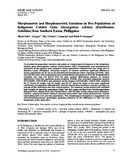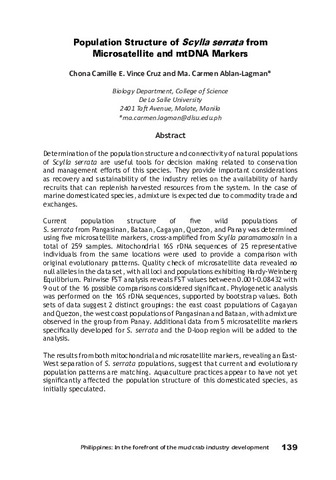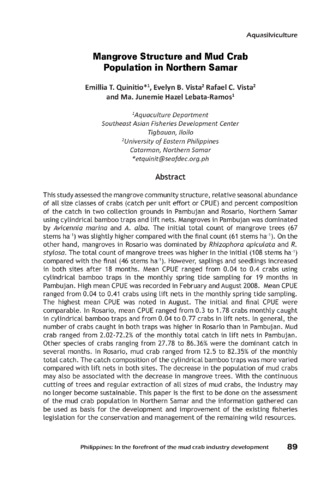Effect of some vertebrate and invertebrate hormones on the population growth, mictic female production, and body size of the marine rotifer Brachionus plicatilis Müller
- Global styles
- MLA
- Vancouver
- Elsevier - Harvard
- APA
- Help
Share
Abstract
Eight vertebrate and invertebrate hormones were screened for their effect on population growth, mictic female production, and body size of the marine rotifer Brachionus plicatilis. Growth hormone (GH) or human chorionic gonadotropin (HCG) at 0.0025-25 I.U. ml-1 and estradio1-17β (E2), triiodothyronine (T3), 20-hydroxyecdysone (20-HE), 5-hydroxytryptamine(5-HT), gamma-aminobutyric acid (GABA) or juvenile hormone (JH) at 0.05-50 mg l-1 were added to 5-ml of Nannochloropsis oculata suspension (7 x 106 cells ml-1). From an initial density of 1 individual ml-1, rotifers were cultured with hormones for 48 hours in 22 ppt seawater at 25 °C, in darkness. Rotifers were counted and classified into female types and transferred to a new algal food suspension without hormone every other day until day 8 when body size was measured. Population growth was significantly higher in treatments exposed to GABA (50 mg l-1), GH (0.0025 and 0.025 I.U. ml-1), HCG (0.25 and 2.5 I.U. ml-1), and 5-HT (5 mg l-1). E2 caused a decrease in population growth, whereas JH, 20HE, and T3 had no effect. Mictic female production was significantly higher at 0.05 and 0.5 mg l-1 JH and 0.05 and 5 mg l- 5HT. GH (0.0025 and 0.025 I.U. ml-1), E2 (50 mg l-1 ), GABA (0.5, 5 and 50 mg l-1), and 20-HE (0.05 mg l-1) treatments had significantly higher mictic female production only on day 8, 6, 4, and 6, respectively. T3 and hCG had no effect on mictic female production. Lorica length increased by 9.6% and 4.4% in rotifers treated with JH (0.05 mg l-1) and GABA (5 mg l-1), respectively. Correspondingly, lorica width increased by 8.9% and 2.6% in these treatments. In comparison, 20-HE-, T3-, and HCG-treated rotifers were smaller (3.9-8.2%) and GH, 5-HT and E2 had no effect on rotifer body size.
Suggested Citation
Gallardo, W. G., Hagiwara, A., Tomita, Y., Soyano, K., & Snell, T. W. (1997). Effect of some vertebrate and invertebrate hormones on the population growth, mictic female production, and body size of the marine rotifer Brachionus plicatilis Müller. Hydrobiologia , 358(1-3), 113-120. https://doi.org/10.1023/A:1003124205002
Type
ArticleISSN
0018-8158Collections
- Journal Articles [1256]
Related items
Showing items related by title, author, creator and subject.
-
Morphometric and morphomeristic variations in five populations of indigenous Celebes goby Glossogobius celebius (Perciformes: Gobiidae) from Southern Luzon, Philippines
Corpuz, Mark Nell C.; Camacho, Ma. Vivian C.; Ocampo, Pablo P. (College of Agriculture, University of the Philippines Los Baños, 2013)To elucidate the population structure and pattern of morphological divergence of the indigenous Celebes goby Glossogobius celebius (Valenciennes, 1837), morphometric and morphomeristic characters of this species were ... -
Population structure of Scylla serrata from microsatellite and mtDNA markers
Vince Cruz, Chona Camille E.; Ablan-Lagman, Ma. Carmen (Aquaculture Department, Southeast Asian Fisheries Development Center, 2017)Determination of the population structure and connectivity of natural populations of Scylla serrata are useful tools for decision making related to conservation and management efforts of this species. They provide important ... -
Mangrove structure and mud crab population in northern Samar
Quinitio, Emilia T. ; Vista, Evelyn B.; Vista, Rafael C.; Lebata-Ramos, Ma. Junemie Hazel
; Vista, Evelyn B.; Vista, Rafael C.; Lebata-Ramos, Ma. Junemie Hazel  (Aquaculture Department, Southeast Asian Fisheries Development Center, 2017)
This study assessed the mangrove community structure, relative seasonal abundance of all size classes of crabs (catch per unit effort or CPUE) and percent composition of the catch in two collection grounds in Pambujan and ...
(Aquaculture Department, Southeast Asian Fisheries Development Center, 2017)
This study assessed the mangrove community structure, relative seasonal abundance of all size classes of crabs (catch per unit effort or CPUE) and percent composition of the catch in two collection grounds in Pambujan and ...





